
Goutweed (Aegopodium podagraria)
FACTS:
- “Goutweed creates dense carpets of vegetation that restrict the amount of sunlight available for native species.” https://www.invasive.org
- “Invasive plant removal is extremely difficult, if not impossible, especially when well-established over large areas.” Grow Me Instead: A Guide for Southern Ontario

As a young gardener, I enjoyed adding new plants to my garden. These days, I keep busy pulling out invasive plant species such as goutweed, which should never have been planted by a neighbour on an adjoining property. These invasives seem like plant monsters, growing wildly and spreading out of control. Imagine the harm when they get into nature. Sometimes I wonder why these garden thugs don’t have warning labels, just like cigarettes.
Julianne Labreche, home gardener, Ottawa Ontario
I was a novice gardener when my mother in law and I came across a delicate, green and white plant growing along a gravel path on my property. We both agreed it was pretty and replanted it in a garden bed. It was not long after I started the MG course through Dalhousie and discovered it was ‘Aegopodium podagraria’ otherwise known as goutweed, bishop’s weed and even “the cockroach of the plant world”. The pretty white and green plant soon became a solid green and quickly spread to take over the shed, garden beds and the wooded area behind our house. The only certain way to get rid of goutweed I read was to “move” and years later I believe that to be true. Yet I still see it being sold in garden centres as the perfect ground cover.
Maureen Bayne; Atlantic Master Gardener, Bedford, Nova Scotia
My three-year-old grandchild was helping me to pull ‘bully plants’ out of the woods beside our home. He asked, “Grandma, why did you plant these bullies?” I had to say that I had not realized they would spread so far from the garden. Many gardeners are unaware that the plants they purchase can spread far and wide and “don’t play nice” with other plants. For the sake of our grandchildren, we need to do better.
Catherine Kavassalis, gardener, southern Ontario

Scots (Scotch) Broom (Cytisus sp.)
FACTS:
- “It easily invades sunny, disturbed sites such as rangelands, roadsides, and areas of recent logging. Scotch broom can increase the intensity of wildfires, obstruct sightlines along roads, and crowd out native plants that animals depend on. A mature plant can live up to 25 years and produce seeds that can survive in soil for 30 years.” Invasive Species Council of BC

Scots Broom is a problem here on Vancouver Island. Volunteers are working hard to reduce its spread. Driving along the main highway, it is common to see parked cars and teams of workers in the fields. I have to confess its gorgeous yellow is beautiful but I know it is bad for wildlife and cattle.
Maggie Sheehan, retiree, Qualicum Beach, BC

English Ivy (Hedera helix)
FACTS:
- “English ivy can form dense monocultures that spread on the ground and on other plants and trees. It can suppress and exclude native vegetation by smothering them and competing for light.” Invasive Species Council of BC
- It “may harbour a plant disease called Bacterial Leaf Scorch (Xylella fastidiosa), that harms elms, oaks, and maples.” Tree Canada
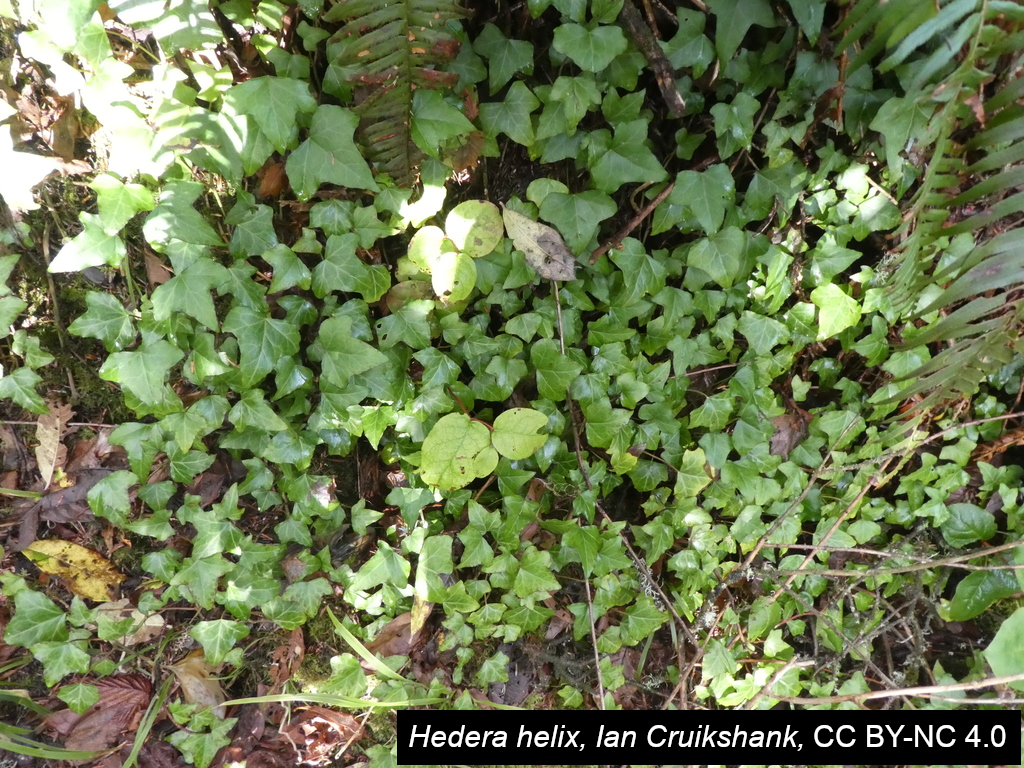
I became aware of invasive species about 15 years ago when, on my walk to work, I noticed some English ivy (Hedera helix) growing in a small wooded area. Then, I realized that English ivy had totally carpeted that area. There were no other plants!
Cheryl Harrison, gardener, Havelock, Ontario

Common Buckthorn (Rhamnus cathartica) and Glossy Buckthorn (Frangula alnus)
FACTS:
- “Common (Rhamnus cathartica) and Glossy Buckthorn (Frangula alnus) are two of Ontario’s most unwanted invasive plants. These non-native buckthorns invade a variety of habitats, with glossy buckthorn often invading wetlands.” Nottawasaga Valley Conservation Authority (NVCA)
- Buckthorn is almost impossible to eradicate. “Once established it maintains itself due to prolific seed production, vigorous growth … ability to regenerate following burning and cutting. The repeated applications of herbicide needed to eliminate R. cathartica are laborious and expensive.” CABI

photo: Scaup (via Inaturalist CC-BY)
When we moved into our home in 1985, it had a huge garden and, being farmers, we set to work getting the garden laid out. To our horror, we found vast areas on the perimeter had been planted in Buckthorn (Rhamnus cathartica) – probably as a privacy fence. Over the past thirty odd years we have removed most of it and we continue to pull it out and cut it down and burn it every year.
Ren Duinker, farmer, Belleville, Ontario
As an added bonus to this nightmare, Goutweed (Aegopodium podagraria) had been planted by the previous owners as a decorative groundcover throughout the garden. That battle also continues… I do not know which one of these insidious plants is worse, the spiky buckthorn or the tenacious goutweed, I have nightmares about both.

Burning Bush (Euonymus alatus)
FACTS:
- You might not be aware that burning bush (Euonymus alatus) is considered to be an invasive plant by the Ontario Invasive Plant Council. It produces a prolific amount of berries and the seeds can germinate both in sunny and shady conditions. Birds aid in seed dispersal. It also reproduces vegetatively by root suckering. It is of particular concern when it is in a garden next to open woodland.” – Toronto Master Gardeners
- “The vibrant berries of this invasive shrub are produced in high volume and can be consumed and deposited away from maintained plantings, enabling this shrub to naturalize outside intended areas.” – Grow Me Instead
- “Creates dense thickets that crowd out and shade native plants, as well as threaten habitats such as fields and prairies.” – Ontario’s Invading Species Awareness Program
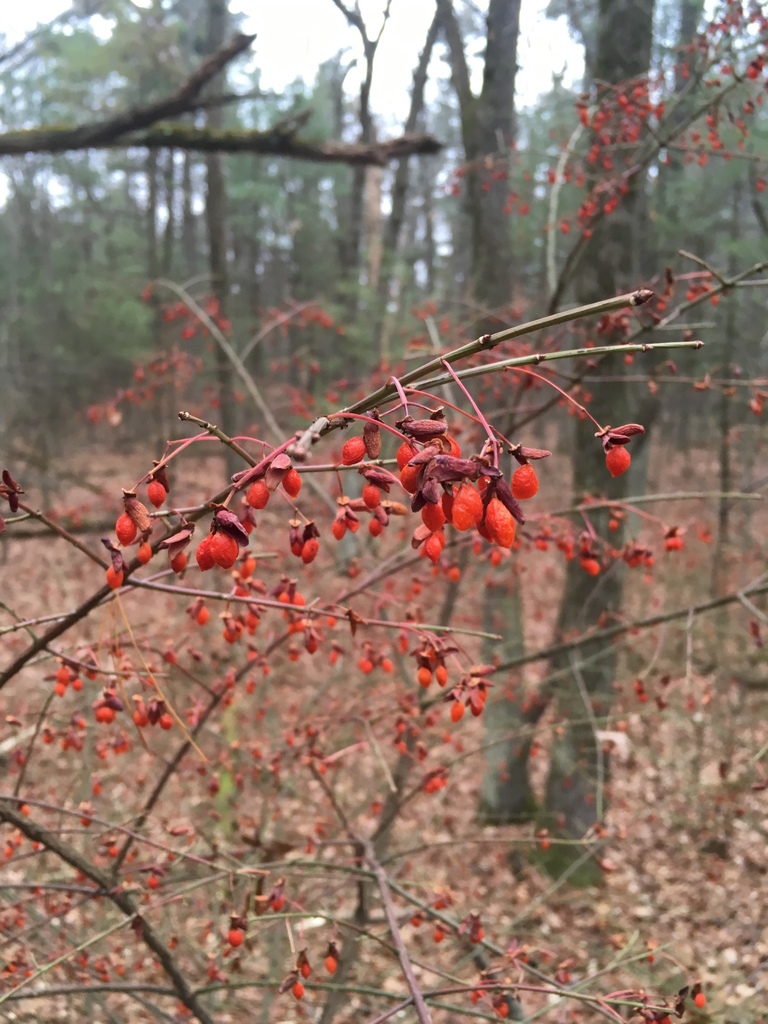
When we moved house, we dug up some of the ‘beautiful’ bushes creeping up the ravine we lived on. The ravine was ablaze with red in the fall so we wanted to introduce some to our new property. We also bought some from our local garden centre. Thank goodness we found out before it was too late that burning bush (Euonymus alatus), also known as winged euonymus, is on the Ontario invasive plant list.
Anne Bremner, home gardener, Inverary, Ontario
I found a number of small bushes in our woodland which I pulled and we have taken out all other bushes. The woodland bushes would have grown from seeds randomly deposited by birds. The harm these plants do is enormous and I am very concerned to see them still being sold in garden centres and big box stores. So many people, like me until recently, have no idea that these plants do so much damage.
Himalayan Balsam (Impatiens glandulifera)
FACTS:
- “Due to its ability to form dense stands and its conspicuous appearance it has been blamed for negative biodiversity effects.”
- “Explosive capsules expel seeds from the plant, and dissemination is also aided by flowing water, seeds transported with sediment and the fact that dry seeds are buoyant.” CABI
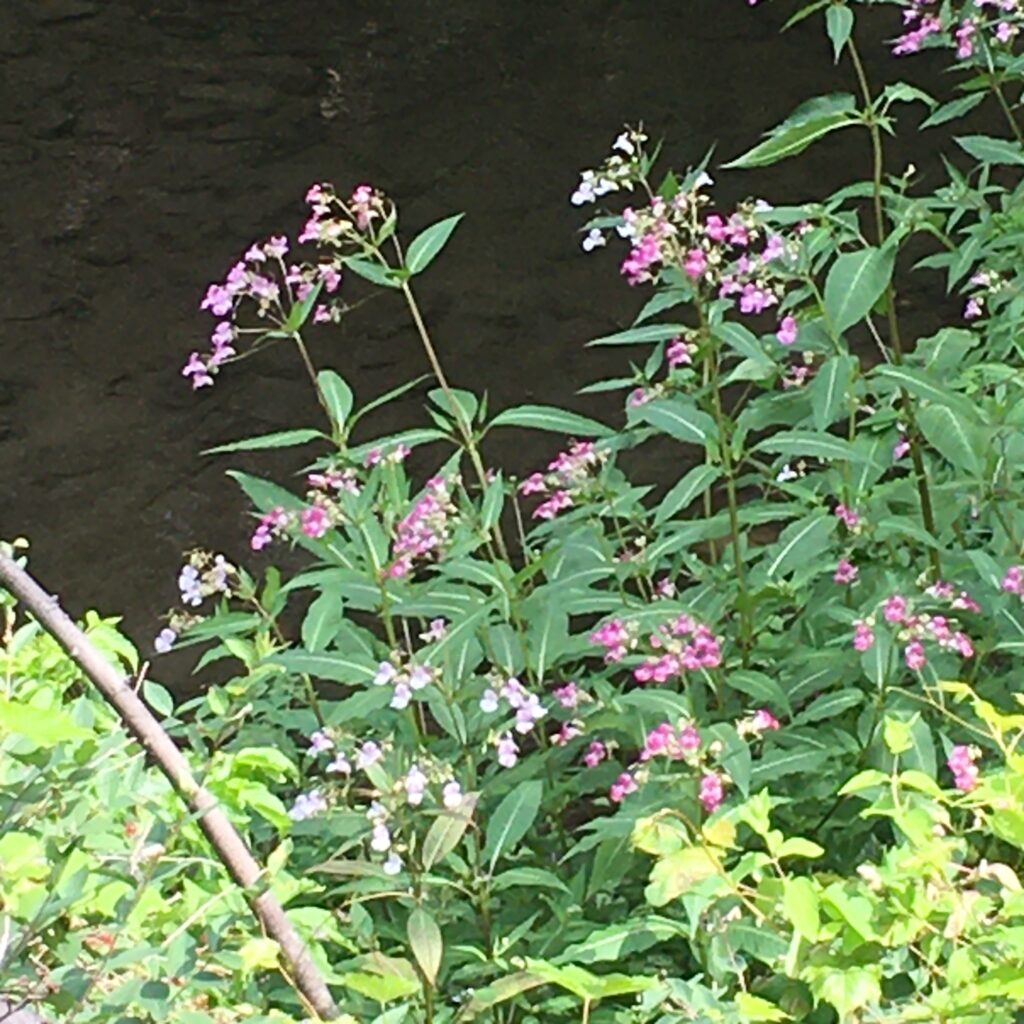
photo: Ian R. Whyte (via INaturalist, CC-O)
Just yesterday, someone in Saskatoon was selling Hollyhock seeds, which is fine, but was throwing in a packet of Himalayan Balsam seeds with each purchase, likely because she had so many of them and thought they were pretty and they attract bees. However, Himalayan Balsam is extremely invasive here.
Chet Neufield, Native Plant Society of Saskatchewan, Saskatoon
When I lived near Tillsonburg Ontario I would attend an annual garden tour hosted by one of the local horticultural societies. One tour, of a large rural property, was memorable for two reasons. First, the gardener had an awe-inspiring display of blue Delphiniums–a towering “Pacific Giant” type in a vibrant blue. Second, the host invited us to ‘help ourselves’ to an unusual but unidentified plant, about three feet tall with pink flowers. There were lots of shovels and bags provided and many in the group pounced on the opportunity for free plants, despite the host’s warning that ‘they show up everywhere’. At the time I was amused at the creative way she had assembled an unpaid weeding crew. Thankfully I did not take any home because, as I later realized, the mystery plant was invasive Himalayan Balsam. I often wonder how many infestations that one “opportunity” had spawned.
Beverley Wagar, gardener, Hamilton Ontario
Beauty in Disguise… Invasive Himalayan Balsam (Impatiens glandulifera) became an ecological problem in some spots along the creek on our farm. It grew aggressively and formed dense patches of tall plants that displaced native plants. Fortunately, its shallow root system made it easy to pull out. After five years of repeatedly pulling out these plants, there is finally no evidence of this Beauty in Disguise.”
Elsie Kathler, gardener, Steinbach, Manitoba

Periwinkle (Vinca sp.)
FACTS:
- “Periwinkle [is] particularly damaging to plant communities in the forest understory. Periwinkle is still sold at some plant nurseries, so this is an existing source contributing to the invasion of this plant across the province.” Ontario Parks
- “Periwinkle leaves are toxic to most grazers and seeds are too small for birds to consume.” Ontario Invasive Species Awareness Council

I joined an online master gardener group recently and soon learned about invasive plants. To my horror, l found periwinkle from two shady gardens and the leaf compost pile had already started its invasion into our woods! I’ve been pulling it and placing black bags of it in hot sun to kill all the parts now for two seasons. One very large area is now cleared. Another, which spread from under an old maple by our driveway, is my next project.
Riana Noyes, Gardener, Thomasburg, Ontario
I found this patch along a hiking trail near Owen Sound, Ontario The patch appeared to come from houses along the edge of the forest. The saddest thing was that the periwinkle stayed on one side of a small creek, until all of a sudden, it breached, and then we could see it growing with abandon on the far side as well.
Heather Doyle, Owen Sound Ontario

Norway Maple
FACTS:
- “Where it has spread from nearby urban seed sources, many ravines, parks and natural areas exhibit nearly pure stands of this species. Its adaptability, ability to cast dense shade, prolific seed production, lack of insect and disease pests and longer leaf lifespan have made it a formidable competitor over native species. It has many competitive advantages over native sugar maple, such as making more efficient use of light, water and nutrients.” OIPC Norway Maple Best Management Practices
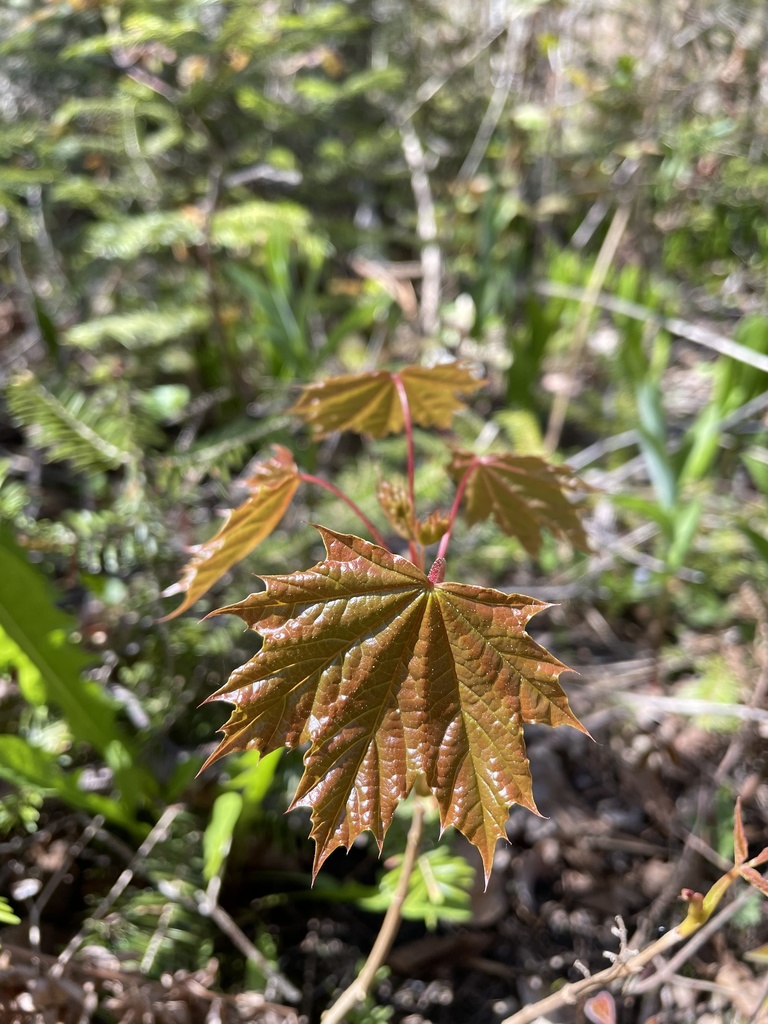
“My two yellow labs and I walk daily, often in various ravines in our neighbourhood. Walking the forest path on the east side in the Humber River valley one day, we emerged to stacks of fresh cut wood piled along the path. A City of Toronto sign indicated Buckthorn, Norway and Manitoba maple were being removed from the area. These are not natives of our forests and it is costing us a tremendous amount to have them removed.”
Leslie Ferguson, gardener and beekeeper, Toronto, Ontario
“From the beginning of landscaping on our Nova Scotia property, we knew it involved planting trees – native trees, if possible. We started with small seedlings from the area. Years later, we discovered some trees were Norway maples (Acer platanoides), native to Europe and Western Asia. This tree can become 40-60’ tall and is a prolific seed producer. It can invade mature forests, inhibiting regeneration of Sugar maples and other native seedlings because its dense canopy provides too much shade for native seedlings.
Sue Stuart, gardener, Nova Scotia
However, Norway maple is susceptible to certain fungi such as Tar Spot, a somewhat unsightly problem that occurs late in the season. I have several large Norway maples. One is in my front yard at the bottom of the driveway. It provides shade in summer but obscures any view of the lake as well as anything else across the street. We try to remove fallen spotted leaves in fall and as many of the multiple seedlings that appear. We have removed several of the large trees that have shaded garden beds. Many more will have to go. Hopefully we can encourage the growth of native maples as we replace invasive Norway maples.”

Japanese Barberry (Berberis thunbergii)
FACTS:
- Japanese barberry “is densely thorned with prolific seed production well into the fall. Birds spread the seed far and wide and branch fragments can readily root to form new shrubs, resulting in this invasive often forming dense thickets. It is also capable of becoming established in a variety of habitats, including areas with partial sunlight and deep shade.” http://www.invadingspecies.com/invaders/plants/japanese-barberry/
- “Japanese barberry can thin out species and numbers of arthropods in a habitat, both herbivores and predators such as ants and spiders, scrambling basic feeding relationships and generating disturbances that can ripple throughout the strands of the web.” Entomology Today
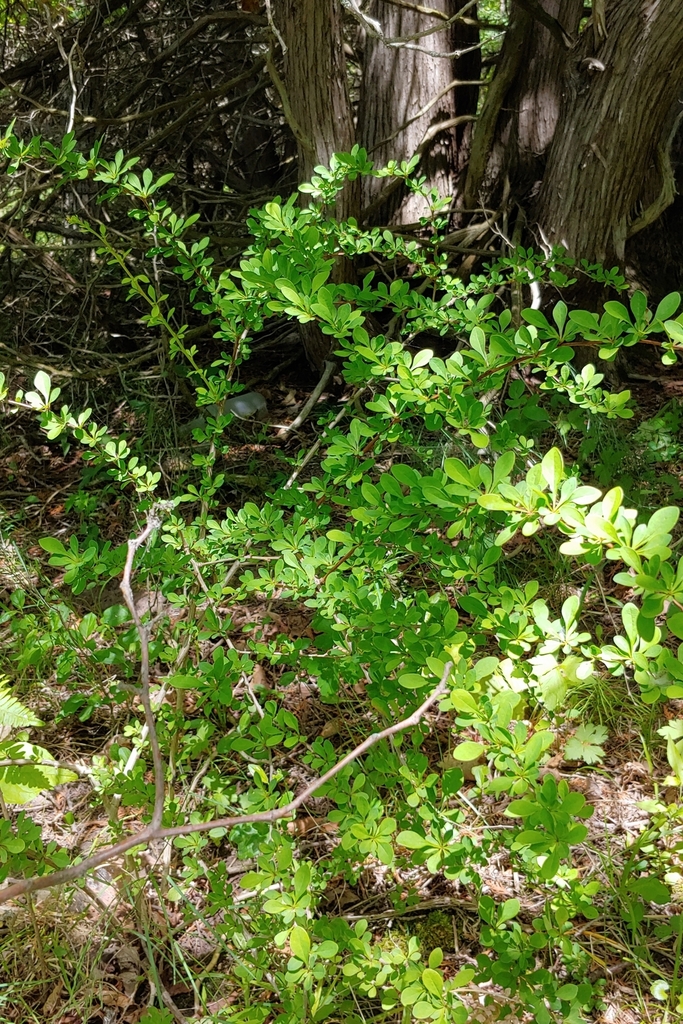
“You never stop learning as a gardener. I wanted pops of red in my backyard, so years ago I planted Japanese barberry (Berberis thunbergii ‘Rose Glow’). It’s hard to rip out a beautiful plant but this had to go when I learned it was invasive. I’m surprised and a bit outraged when I still see it for sale.”
Anne Craig, home gardener, Peterborough, Ontario
“I am a 52-year-old avid gardener and outdoorsperson who grew up in Puslinch, Ontario on 23 acres of sugar maple, agricultural land and forested dwelling. I am intimately familiar with my surroundings. I did not know that Japanese barberry (Berberis thunbergia) was invasive, let alone dangerous, back in 2012 when I first got sick.
Laura Black
Because I live in a heavily wooded area and do not clean up the forest floor or edges, there are quite a few ticks. I dress accordingly and do checks on myself and my dog, who sadly passed away from what ailed us.
After several years and thousands of dollars, I received a diagnosis of chronic Lyme disease due to Borrelia burgdorferi, bacterium carried by ticks. I never saw a bite mark on my body. I never got the classic Bullseye rash. In fact, no one believed me until I sent bloodwork to be immunoblotted. By the time this was discovered, I was antibiotic resistant and western medicine was no longer able to help me.
I only discovered the Japanese barberry shrub was threatening my life when I had an ecological survey done on my property for a severance application. The bush area where I had spent decades playing as a child was full of ticks. I must have been infected at some point. However, it was at least two years before severe symptoms surfaced.
I spent three years solarizing the entire area and then dug everything up to start over. I started vermicomposting and placed several inground farms in the soil to replenish it. In place of the Berberis thunbergia, I planted a few serviceberries and several clumps of natives.
I was afraid to be outdoors for at least a year or two after discovering the source of my Lyme disease and nearly gave up gardening altogether. I was depressed, tired and feeling defeated. One shrub turned my world upside down. Sure, there were other shrubs that probably had lots of ticks as well. However, it was the Japanese barberry that was identified as the culprit by the experts.
Please never buy this plant. Never put it in the ground. If you have it, get it out of there. Save yourself and your loved ones the grief, heartache, hospital stays and financial distress.”
Puslinch, Ontario
